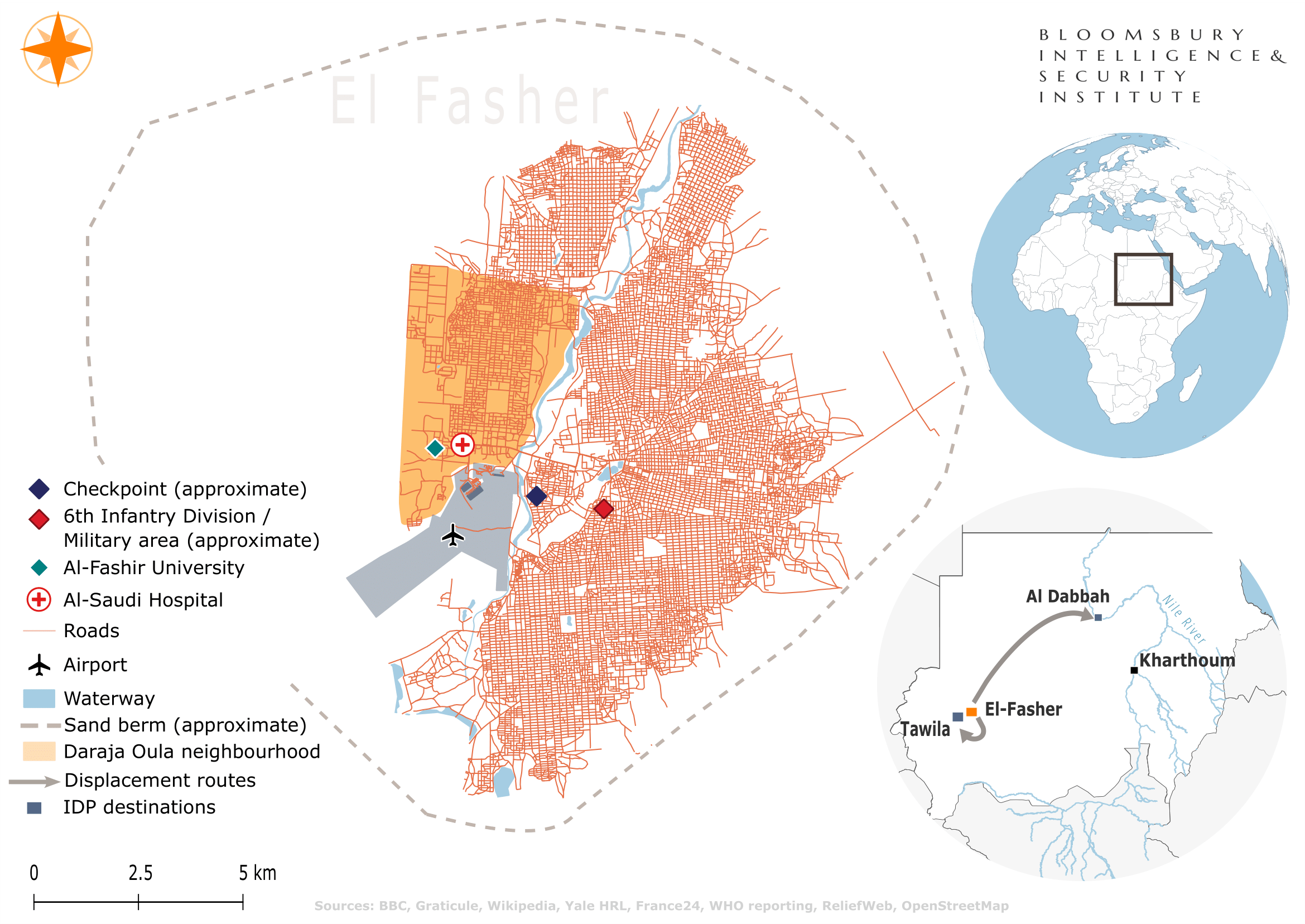From Siege to Fragmentation: How the Fall of Al-Fasher Redefined Sudan's War
By Hossamaldeen Ibrahim | 20 November 2025
Map of El Fasher, Sudan, by Jeanne-Mây Desurmont
Summary
The Rapid Support Forces (RSF) seized Al-Fasher whilst peace talks were underway in Washington D.C. signaling a military-first strategy.
Yale Humanitarian Research Lab satellite imagery confirms mass killing, filtration operations, and destroyed vehicles, whilst Armed Conflict Location & Event Data Project (ACLED) records nearly 400 civilian-targeting incidents in Al-Fasher since 15 April 2023 beginning of the war.
The fall of Al-Fasher consolidates RSF control of the Darfur region, heightens risks of de facto partition, fuels regional instability, and increases irregular migration pressures toward neighbouring countries and Europe.
Context
On 26 October 2025, the RSF captured Al-Fasher, the last Sudanese Armed Forces (SAF) stronghold in Darfur, after more than 500 days of siege. The offensive coincided with indirect negotiations in Washington between SAF and RSF representatives, organised by the US State Department with support from the Quartet (United States, Saudi Arabia, United Arab Emirates (UAE), Egypt). The Yale School of Public Health’s Humanitarian Research Lab (HRL) released an Atrocity Alert on 31 October which documented at least 31 clusters of objects consistent with bodies across Al-Fasher. Satellite imagery corroborated massacres . HRL also identified filtration operations in Garni, where men and boys were reportedly executed or disappeared.
The International Organization for Migration (IOM) reported that 90,000 people were displaced from Al-Fasher between 26 October and 11 November, out of an estimated 250,000 residents. This unusually low displacement rate compared to previous RSF assaults suggests that large-scale killings or containment have taken place in Al-Fasher. Reports also document conflict-related sexual violence, including rape during clearance operations. ACLED data shows nearly 400 incidents of civilian targeting in Al-Fasher since April 2023, with over 55% recorded in 2025 and more than 1,400 reported deaths.
The Washington talks aimed to establish a humanitarian ceasefire, reactivate the Jeddah platform, launched in May 2023 by the United States and Saudi Arabia, and seek a humanitarian truce and ceasefire between the SAF and the RSF. However, it failed to achieve results due to continued fighting, mutual distrust and the absence of an enforcement mechanism.
Implications
The recent escalation, combined with large-scale displacement toward towns such as Al-Dabbah, reflects deepening political, security, operational, and economic risks for civilians and stakeholders across Sudan. Politically, the RSF’s continued use of force, particularly during the Washington talks, has galvanised segments of the population to rally behind the SAF, which many now view as the only remaining barrier against the RSF’s expansion and the immediate threat it poses to the safety and existence of communities in Darfur. This shift, however, does not translate into confidence in the SAF’s capacity, which remains militarily weakened and unable to protect civilians or negotiate effectively, further reducing public trust in national authorities and international mediation frameworks.
From a security perspective, civilians in RSF-controlled or contested areas face extreme risks, including execution, rape, forced disappearance, and targeted violence linked to identity and territorial control. Siege tactics, filtration hubs, and the deliberate obstruction of aid have become defining operational features of RSF advances, entrenching its control while preventing humanitarian actors from reaching populations in need. These operational barriers not only intensify civilian suffering but also diminish the ability of humanitarian agencies to plan and respond, undermining the broader humanitarian system already strained by mass displacement.
Economically, the collapse of urban centres and trade networks in Darfur has disrupted local markets, agricultural production, and supply routes, deepening poverty among communities who are already unable to finance safe escape routes or cross-border migration. As a result, displacement patterns now favour internal movement toward nearby towns such as Tawilah and Al-Dabbah, while only families with financial resources pursue irregular migration toward neighbouring countries or onward to Europe. This widening economic divide further complicates the humanitarian response, as the most vulnerable remain trapped within Sudan’s deteriorating economic and security environment.
Geopolitically, external support continues to sustain both warring parties: the UAE backs the RSF, while Egypt and Turkey support the SAF, reinforcing a battlefield logic that overshadows diplomatic initiatives. The collapse of the Washington track has weakened the Quartet’s credibility and highlighted the limited leverage of international mediators. For regional actors and local communities, the outcome has reaffirmed the primacy of military gains over negotiation, diminishing trust in future mediation efforts and increasing the likelihood that the conflict will continue to escalate in the absence of unified external pressure.
Mohamed Tohami/Unsplash
Forecast
Short-term (Now - 3 months)
Continued killings, sexual violence, and filtration in El-Fasher will highly likely persist, with humanitarian access remaining blocked and displacement continuing toward Tawilah and Al-Dabbah.
Medium-term (3-12 months)
The RSF will likely consolidate its control over Darfur and increase pressure on Kordofan, while the SAF entrenches along the Nile corridor. Washington talks will likely stall, and regional spillovers into Chad and Egypt will likely intensify.
Long-term (>1 year)



